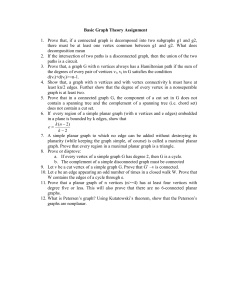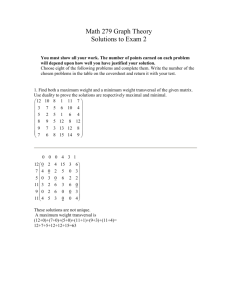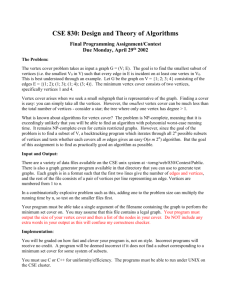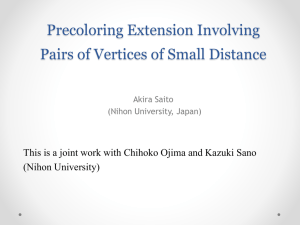solutions
advertisement
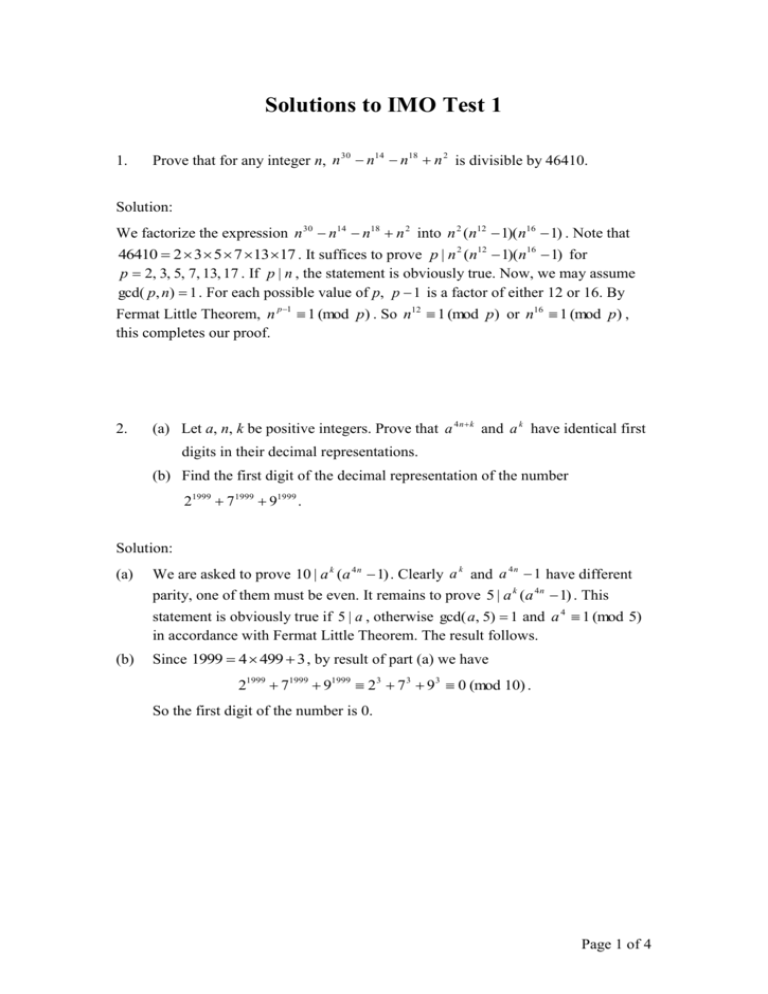
Solutions to IMO Test 1
1.
Prove that for any integer n, n 30 n14 n18 n 2 is divisible by 46410.
Solution:
We factorize the expression n 30 n14 n18 n 2 into n 2 (n12 1)( n16 1) . Note that
46410 2 3 5 7 13 17 . It suffices to prove p | n 2 (n12 1)( n16 1) for
p 2, 3, 5, 7, 13, 17 . If p | n , the statement is obviously true. Now, we may assume
gcd( p, n) 1 . For each possible value of p, p 1 is a factor of either 12 or 16. By
Fermat Little Theorem, n p 1 1 (mod p) . So n12 1 (mod p) or n16 1 (mod p) ,
this completes our proof.
2.
(a) Let a, n, k be positive integers. Prove that a 4 n k and a k have identical first
digits in their decimal representations.
(b) Find the first digit of the decimal representation of the number
21999 71999 91999 .
Solution:
(a)
We are asked to prove 10 | a k (a 4 n 1) . Clearly a k and a 4 n 1 have different
parity, one of them must be even. It remains to prove 5 | a k (a 4 n 1) . This
statement is obviously true if 5 | a , otherwise gcd( a, 5) 1 and a 4 1 (mod 5)
in accordance with Fermat Little Theorem. The result follows.
(b)
Since 1999 4 499 3 , by result of part (a) we have
21999 71999 91999 2 3 7 3 9 3 0 (mod 10) .
So the first digit of the number is 0.
Page 1 of 4
3.
Let ABC be an acute triangle. Suppose a circle 1 , with center O1 , touches the
sides BC produced at E, AC produced at G, and AB at C . Suppose also that
another circle 2 , with center O2 , touches the sides AB produced at H, BC
produced at F, and AC at B . Let the extensions of EG and FH intersect at P.
Prove that PA BC .
Solution:
H
G
A
M
N
I
E
B
L I’
C
F
Let L, M, N be respectively the feet of perpendicular from A, B, C to the segments BC,
FH, EG. Note that L, M, N are points lied on the sides of IBC , and LA, MH, NG are
lines through L, M, N which perpendicular to the sides of IBC . We want to prove
LA, MH, NG are concurrent, by Carnot Theorem, it is equivalent to
( BL2 LC 2 ) (CN 2 NI 2 ) ( IM 2 MB 2 ) 0 --------------- (1)
Note that CN 2 NI 2 (CE 2 EN 2 ) ( IE 2 EN 2 ) CE 2 IE 2 . Similarly we have
IM 2 MB 2 IF 2 BF 2 . Adding these two equalities and using the relation
BF CE to make a simplification, we obtain
CN 2 NI 2 IM 2 MB 2 IF 2 IE 2 -------------------- (2)
Compare (1) and (2), it remains to prove IE 2 IF 2 BL2 LC 2 ------------------- (3)
Denote I be the foot of perpendicular from I to the segment EF and p ( BF CE )
be the semi-perimeter. Then I E CE CI p ( p c) c (recall that c denote the
length of AB). Similarly I F b .
So IE 2 IF 2 I E 2 I F 2 AB 2 AC 2 BL2 LC 2 , this proved (3).
Hence, the lines LA, MH, NG are concurrent at a point. This point is P and follows
that PA BC .
Page 2 of 4
4.
Let a, b, c, d , l , m, n, r be given (fixed) positive numbers. Suppose x, y, z , w are
positive numbers satisfying ax by cz dw 2 . Determine the minimum of
F
l m n r
.
x y z w
Solution:
By Cauchy-Schwarz Inequality,
2F (
So F
al bm cn dr
)( ax by cz dw) ( al bm cn dr ) 2 .
ax by cz dw
1
( al bm cn dr ) 2 .
2
l
m
n
r
. With the given condition
:
:
:
a
b
c
d
ax by cz dw 2 , we can solve for the corresponding values of x, y, z , w .
Equality holds when x : y : z : w
In fact, these values are
x
z
2
al bm cn dr
2
al bm cn dr
l
,
a
y
n
,
c
w
Hence, the minimum value of F is
5.
2
al bm cn dr
2
al bm cn dr
m
,
b
r
.
d
1
( al bm cn dr ) 2 .
2
For a graph G, G = min{k: G has a k-coloring}, G = max{degrees of vertices
of G}
(a) Prove that for any simple connected graph G, G G 1 .
(b) A regular graph is a graph that every vertex has the same degree. Prove that
if a simple connected graph G is not regular, then G G .
Solution:
(a)
We are going to prove there is a ( G 1) -coloring for any simple graph G
(not necessary connected). Without loss of generality, we use induction on n,
the number of vertices of graph G.
For n G 1, clearly there is a ( G 1) -coloring.
Page 3 of 4
Assume the statement is true for a positive integer k G 1 . For example,
any simple graph G with k vertices has a ( G 1) -coloring.
Now, consider a graph G with k 1 vertices. We may choose an arbitrary
vertex v and then remove it from the graph (of course, we remove the edges
incident with v at the same time). This gives a new graph G with k vertices.
By assumption, the graph G has a ( G 1) -coloring and follows that it has
also a ( G 1) -coloring (since G G ). Then we put back the vertex v to
the graph, it adjacent with at most G vertices and there must be a suitable
color that we can assign this color to the vertex v. This gives a ( G 1) coloring to the graph G.
By principle of mathematical induction, any simple graph G has a ( G 1) coloring. Hence, G G 1 .
(b)
Similar to part (a), we need to prove there is a G -coloring for any simple
non-regular graph G. (In fact the proof is almost the same as part (a))
With the same notation as part (a), we use induction on n.
For n G 1, since the graph is not regular, we may choose a vertex v, with
deg v G , from the graph and first arbitrarily assign color to the other
vertices (of course, adjacent vertices are assigned by different colors). Then
there must be a color which is unused, we may assign this color to vertex v in
order to give a G -coloring to the graph.
Assume the statement is true for a positive integer k G 1 . For example,
any simple non-regular graph G with k vertices has a G -coloring.
Now, consider a graph G with k 1 vertices. Since the graph G is not regular,
we may choose a vertex v from the graph with deg v G . Remove this
vertex from the graph, this gives a new graph G with k vertices. By
assumption, the graph G has a G -coloring. So it has also a G -coloring.
Next, we put back the vertex v to the graph, it adjacent with at most G 1
vertices and there must be a suitable color that we can assign this color to the
vertex v. This gives a G -coloring to the graph G.
By principle of mathematical induction, any simple non-regular graph G has a
G -coloring. Hence, G G .
~ The End ~
Page 4 of 4



